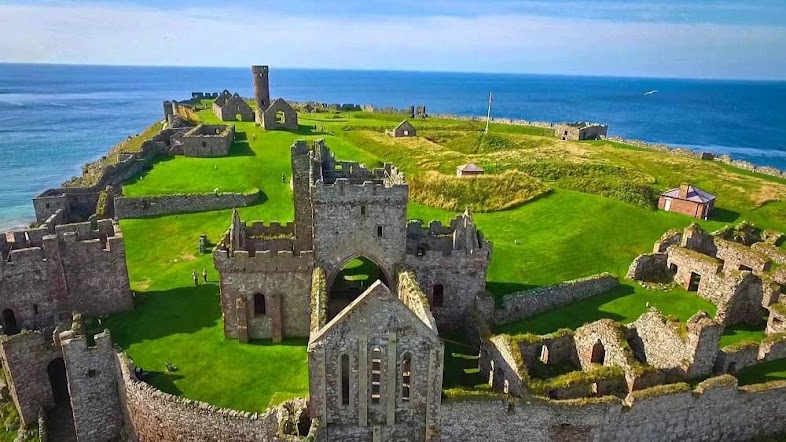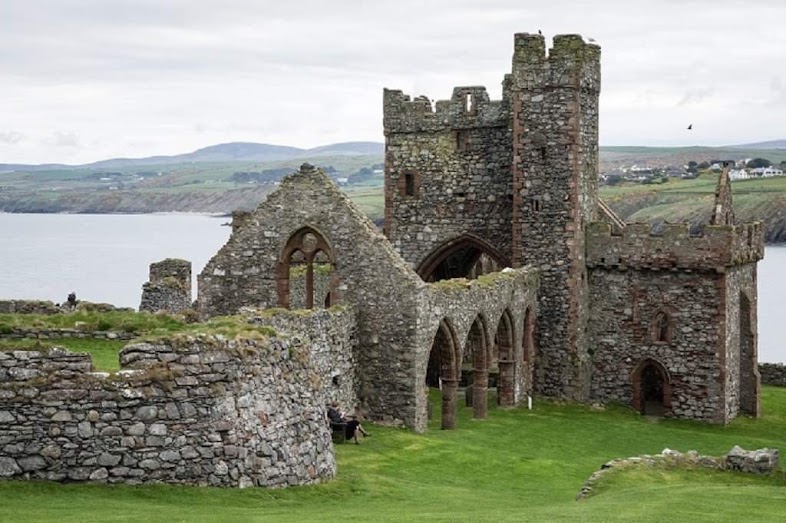Peel Castle is one of the most iconic landmarks on the Isle of Man, located on the west coast of the island, overlooking Peel Bay. The castle’s ruins are a fascinating reminder of the island’s rich history, dating back to the Viking era. Peel Castle played an essential role in the island’s political, religious, and cultural life for many centuries, and it remains a significant symbol of Manx identity to this day. In this article, we will explore the history, legends, and significance of Peel Castle.
Table of contents
History of Peel Castle
The history of Peel Castle can be traced back to the 11th century when the Vikings first arrived on the Isle of Man. The castle was built on St. Patrick’s Isle, a small island that was once separated from the mainland by a narrow causeway. The castle was initially a wooden fortification built by the Vikings to protect themselves from the Irish and the other Viking groups.
Over the centuries, the wooden fortress was replaced by a stone castle, which served as the primary residence of the Manx kings. The castle was expanded and rebuilt several times, with each new structure reflecting the changing architectural styles and tastes of the times. The castle’s most notable features include the Keep, the Round Tower, and the Old Cathedral.
Legends of Peel Castle
Peel Castle is steeped in legend and folklore. One of the most famous legends associated with the castle is that of the Moddey Dhoo, a ghostly black dog that is said to haunt the castle. The Moddey Dhoo is said to be the spirit of a guard dog that belonged to a castle watchman who died in mysterious circumstances. The dog is said to wander the castle at night, howling and barking, and has been the subject of many ghost stories and legends over the years.

Another legend associated with Peel Castle is that of the fairy bridge, a small stone bridge near the castle that is said to be the entrance to the fairy world. According to legend, anyone who crosses the bridge must greet the fairies, or they will suffer bad luck. The bridge has become a popular tourist attraction, and many visitors still adhere to the tradition of greeting the fairies.
Architecture and Features of Peel Castle
Peel Castle is a fascinating example of medieval architecture, and its ruins offer a glimpse into the castle’s past. The castle’s most prominent feature is the Keep, a large stone tower that was built in the 14th century. The Keep was designed to be the center of the castle’s defense and was equipped with a range of defensive features, including arrow slits, murder holes, and a drawbridge.
The Round Tower is another significant feature of the castle. It is a circular tower that was built in the 11th century and is the oldest surviving structure on the island. The Round Tower served as a watchtower and provided a clear view of the surrounding sea and countryside.
The Old Cathedral is another essential feature of the castle. It was built in the 13th century and was the primary place of worship on the island until the construction of St. German’s Cathedral in the 19th century. The Old Cathedral is now a ruin, but its impressive architecture and beautiful location make it a popular destination for visitors.
The Role of Peel Castle in Isle of Man’s History
Peel Castle has played a vital role in the history of the Isle of Man. It served as the primary residence of the Manx kings and was the center of political and religious power on the island for many centuries. The castle was also the site of several key historical events, including the capture of the last Manx king, Magnus III, by the Scots in 1265. Magnus III had sought refuge in the castle after losing a battle to the Scottish army. However, he was betrayed by his own people, who revealed his hiding place to the Scottish army, resulting in his capture and subsequent imprisonment.
Peel Castle also played a significant role in the island’s religious life. The Old Cathedral served as the primary place of worship on the island for several centuries and was an essential center of religious power. The bishops of Sodor and Man, who were responsible for the spiritual life of the island, resided in Peel Castle and held court there.
During the English Civil War, Peel Castle was used as a prison for royalist soldiers who were captured by the parliamentarians. Many of these soldiers were held in terrible conditions and suffered greatly during their captivity. The castle’s role as a prison continued well into the 19th century when it was used to house prisoners of war during the Napoleonic Wars.
Significance of Peel Castle Today
Today, Peel Castle is a significant tourist attraction and a symbol of Manx identity. The castle’s ruins are a testament to the island’s rich history and offer visitors a unique insight into the castle’s past. The castle’s location on St. Patrick’s Isle, overlooking Peel Bay, makes it one of the most picturesque landmarks on the island, and it has been featured in many films and television shows.
Peel Castle is also a vital part of the island’s cultural life. The castle is the site of many events and celebrations throughout the year, including the annual Peel Viking Festival, which celebrates the island’s Viking heritage. The castle is also a popular destination for artists, writers, and musicians, who are inspired by its rich history and stunning location.
Conclusion
Peel Castle is a fascinating reminder of the Isle of Man’s rich history and cultural heritage. Its ruins offer visitors a glimpse into the castle’s past, from its Viking origins to its role in the island’s political and religious life. The castle’s legends and folklore add to its mystique, and its significance as a tourist attraction and symbol of Manx identity is undeniable. Peel Castle is a unique and essential landmark on the Isle of Man, and its continued preservation and promotion are vital to the island’s cultural and economic life.



 For all latest articles, follow on Google News
For all latest articles, follow on Google News